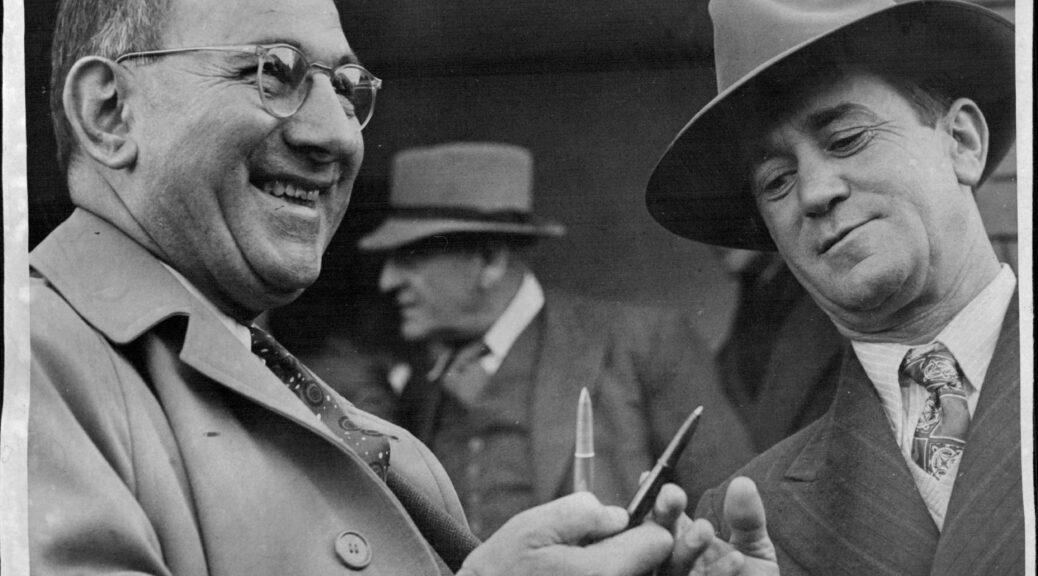
Nibby Sunday – Milton Reynolds – The Ballpoint King
This article was originally published in Norwegian at Pennen er mektigere on May 2, 2021.
When you search in old Norwegian newspaper archives for the name “Milton Reynolds”, you find a lot of articles that mention two specific events in particular. One happened in 1947, when he flew around the world with his plane “The Reynolds Bombshell” in 78 hours and 55 minutes, thereby setting a new record for circumnavigating the world. The other case that was widely reported in Norwegian newspapers was the lawsuit against his Norwegian pen factory in the spring of 1949.
Milton Reynolds’ history as a pen maker left a big mark, and despite the man himself only being in the pen business for a four-year period, he has become a legend, and perhaps one of the biggest personalities in the industry’s history. But what did the American globetrotter and businessman do to secure this status, and in what way did he become part of Norwegian pen history? We will look at that in this post.
The birth of the ballpoint pen
Before we embark on Reynolds’ story, it’s important to know a little about the background. This is also the story of the ballpoint pen. The first patent for a ballpoint pen was actually registered as early as in 1888, when John J. Loud tried to construct a pen that could write on uneven surfaces, such as wood, leather and rough paper. The resulting pen ended up being a rather poor writer on ordinary paper, and this limited area of use meant that it was never put into production on a larger scale. Years passed, and Loud’s patent quietly expired.
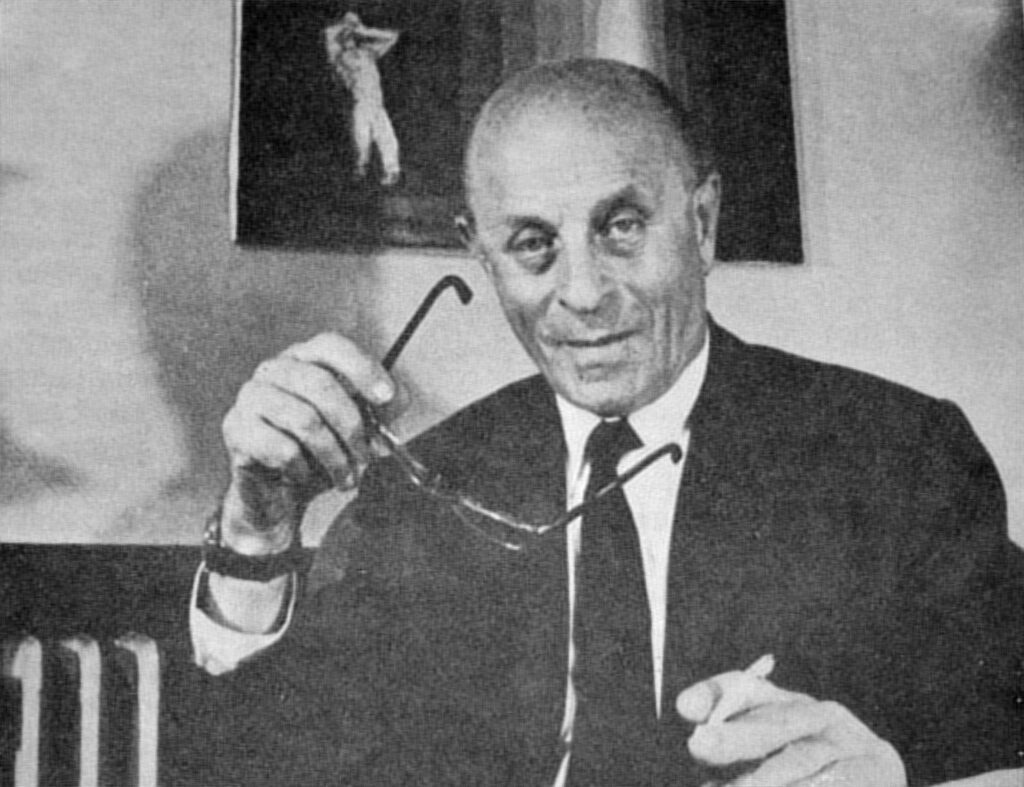
Several people experimented with different varieties of ballpoint pens in the years that followed, but no one succeeded in making a reasonably reliable pen until Hungarian newspaper editor László Bíró had an idea. He was annoyed by the long drying time of fountain pen ink, and was tired of all the stains after dragging wet ink across the paper he was writing on. He noticed that the ink used for printing newspapers dried much faster. Together with his brother, he began experimenting with similar inks, and in 1938 registered a patent for a working ballpoint pen. In 1941, the two brothers fled Europe, and ended up in Argentina, where they eventually founded the company “Bíró Pens of Argentina”, and started selling ballpoint pens. In the summer of 1945, the companies Eversharp and Eberhard Faber entered into a partnership to buy the rights to produce and sell the Bíró pens in the US. And this is roughly where Milton Reynolds comes into play.
Milton Reynolds
Milton Reynolds was 53 years old in 1945, and had had a long and somewhat mixed career as a businessman. He had tried his hand in several different industries, and had experienced both ups and downs. He traveled a lot in South America in the 40s, and it was during a trip to Buenos Aires that he came across a Bíró pen for the first time. At this point, he was in a career slump. He had some money in his account after doing a deal involving Mexican cigarette lighters, but he was looking for something new and profitable to do. Reynolds was the type to seize any business opportunity he got, and he immediately saw potential in the pens. This was a golden chance to get into a large market early. The fact that Bíró had entered into an agreement with Eversharp did not stop Reynolds. He bought a handful of pens, and took them back to the United States.
He probably realized that he would have to be quick to take full advantage of this opportunity. He picked the pens apart, and hastily constructed a new pen based on the same technology. To escape Bíró’s patent, the flow of ink in Reynolds’ pen was controlled by gravity (the Bíró pens, on the other hand, used capillary force to get the ink down to the ball). To make a ballpoint pen work with gravity, Reynolds had to develop a thinner ink, which he called “SatinFlo,” and this in turn made his pens more prone to leaks. Reynolds, however, didn’t bother spending the time and effort to fix these problems.
He had another company (Reynolds Printasign), which sold equipment for making signs, and through this company he had many contacts with large department store chains in the USA. He used these contacts for all they were worth, and armed with only one prototype of his pen, he persuaded the owner of Gimbel’s Department Store to order 50,000 pens before production even began. He assembled a makeshift factory in a converted tennis hall, bought cheap materials from military surplus storehouses (of which there was more than enough in the late summer of 1945), and managed to get his pen on the market before Eversharp.
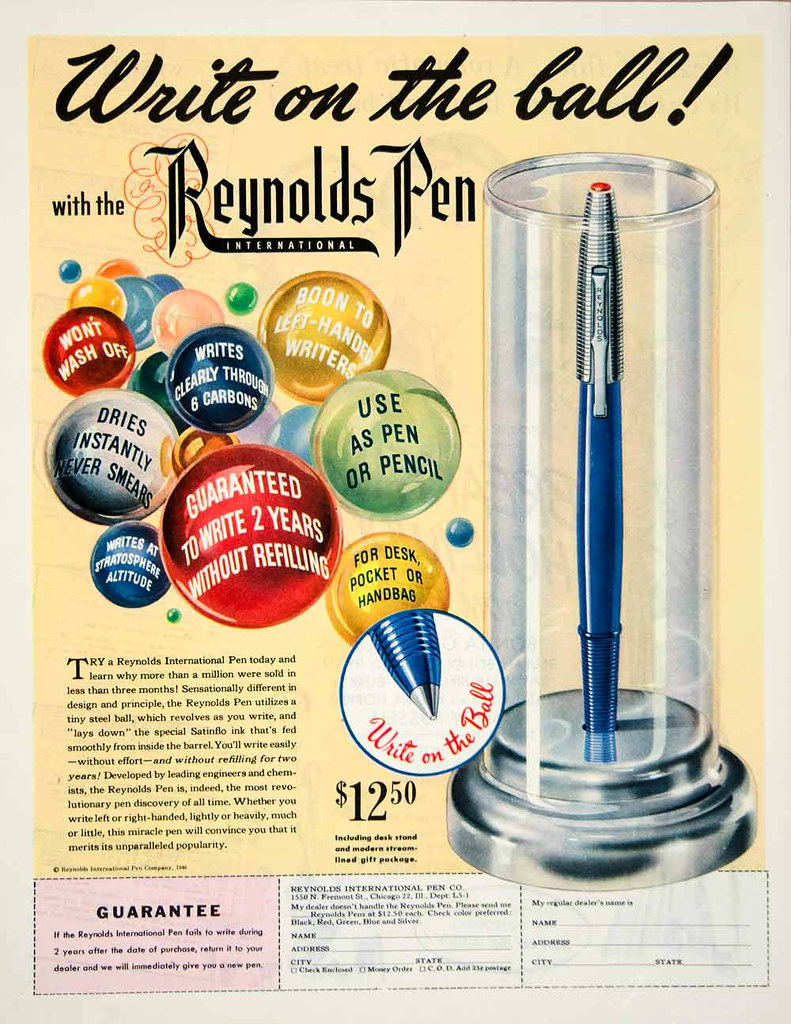
The ballpoint hysteria in the winter of 1945-46
The Reynolds pen was launched with great fanfare at Gimbels in Manhattan on October 29, 1945. Americans were still elating from Japan’s surrender a month and a half earlier, and the United States had only just emerged from the Great Depression right before the war. The purchasing power and enthusiasm in the American people was stronger than it had been since the late 1920s, and Reynolds realized that the pre-Christmas sales of 1945 were going to be something out of the ordinary. On the morning of October 29, Gimbels was practically stormed by 5,000 eager customers who wanted to secure the first ever commercial ballpoint pen. The New York City police had to deploy 50 police officers to control the crowds.
Reynolds knew how to capitalize on the pen’s popularity. To begin with, it cost him approx. 80 cents to produce one pen, but he sold them for $12.50. These were not cheap pens. In today’s value, it corresponds to around 185 dollars. As he increased production, his own costs fell to 8 cents per pen, without changing the selling price.
Naturally, Eversharp did not like this, believing that Reynolds had trespassed on their hunting grounds. They soon launched their own ballpoint pen, and at the same time sued Reynolds for patent fraud. Reynolds, in turn, sued them back for trying to stop him from selling his products. In American newspapers, this was referred to as “The Pen Wars”. The two lawsuits were for the same amount, and canceled each other out, but in the heat of the battle, both companies received heaps of valuable PR.
The ballpoint pen market just grew and grew, and Reynolds was unable to meet the demand. He therefore started selling gift cards instead, which could be exchanged for pens at a later date. On the first day, he sold $100,000 worth of gift cards, and this helped him expand his business. Three months after the launch of the first pen, he had 800 employees in the factory, producing 30,000 pens every single day. He had to strike while the iron was hot, and Milton Reynolds did not rest on his laurels. He designed several new pens, and literally threw them onto the market. Among other things, he came up with a ballpoint pen without a cap, where you twisted the grip section to push the tip out and in.
It wasn’t the quality that made the Reynolds pens so popular. They represented something new and exciting, and had catchy slogans in their advertisements. Nevertheless, in the first few months after the pen was launched, over 100,000 pens were replaced due to defects, but customers were still happy as long as they actually got the pens replaced. Many also experienced having their shirts and jackets ruined because, as the Norwegian newspaper Friheten wrote ten years later, “if you carried a Reynolds pen in your breast pocket, the ink tended to expand from body heat, which sometimes resulted in the pen exploding in a silent splash”. Several people sent demands for Reynolds to cover the loss of clothing. The ink was water proof, and didn’t wash out (one of Reynolds’ catchphrases was “It writes under water!”). The company had a warranty on the pens, but didn’t take responsibility for damaged clothing, and any complaints in the media were completely drowned out by all the advertising hype.
Reynolds was an expert in marketing, and among other things gave cash prizes to the shops that had the best window displays with his pens. He made sure to give pens to celebrities, athletes, politicians and others who he knew would use the pens in public. He also sent a box of 200 pens to President Harry Truman, with the words “I swiped this from Harry S. Truman” printed on every pen. Truman loved it, and began giving away the pens as fun gifts to ambassadors and other dignitaries. Many believe that the tradition of giving away presidential signature pens originated with this box of Reynolds pens. Only half a year after the launch of the first pen, Reynolds pens could be bought in 37 different countries, and Milton himself had long since become a multi-millionaire.
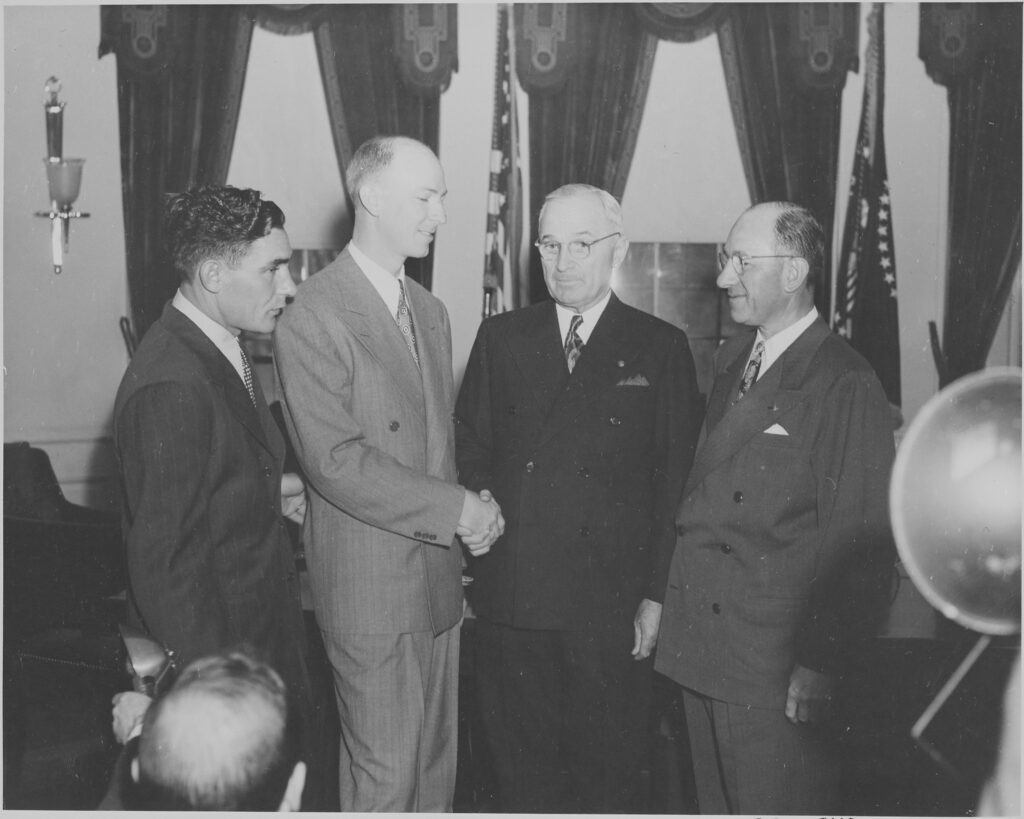
Reynolds Bombshell
Reynolds realized early on that this was not going to be a lasting success for him. As soon as the big pen brands like Eversharp, Parker and Waterman’s came on the market with their own ballpoint pens, they had the opportunity to produce cheaper pens, and probably of better quality than his own. Reynolds’ genius and cunning lay in the way he took advantage of the period immediately after the war, diving head-first into the market before anyone else could react. When he felt things starting to slow down, he always had a new invention lurking, and that’s where his 1947 round-the-world flight came into play. He bought a discarded B-26 bomber from the US Defense Forces, and rebuilt it for the record attempt. He christened the plane “The Reynolds Bombshell” and loudly announced that he intended to break the record set by Howard Hughes in 1938. At all stops during the trip, he made sure to hand out pens to associates and others who happened to be nearby. He timed the record attempt with the launch of a new pen model called “The Reynolds Rocket”, and used the record to promote the pen. Later he also launched a pen named after the plane (“The Bombshell”). This one wrote with two colours, and was a small sensation when it arrived in the stores.
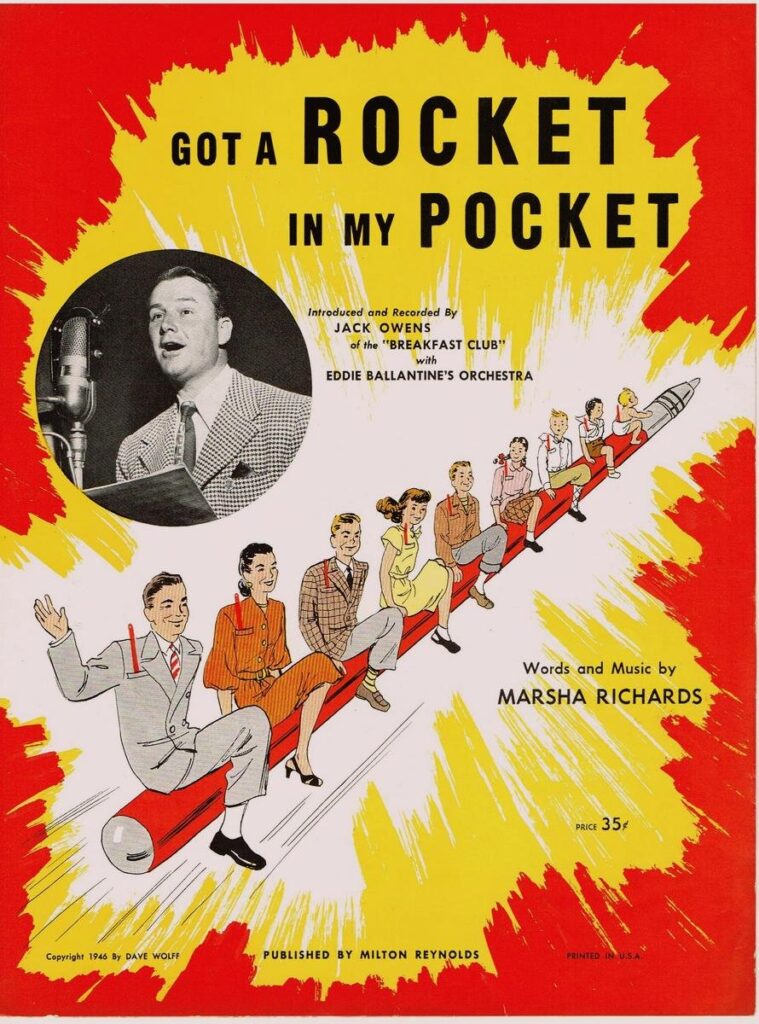
According to the advertisements, the Rocket pen could write for 15 years without needing to be refilled. This pen was, among other things, the source of inspiration for the song “Rocket in My Pocket”, which has been recorded by several artists over the years, including Jimmy Lloyd in 1958:
As mentioned, Reynolds realized that the big American pen brands would soon compete for the American market, and he was absolutely right. It didn’t take long before the market was flooded with various ballpoint pens, and when Reynolds no longer had the monopoly on the ballpoint pen market, prices began to plummet. Pens that cost $15 in 1945 could be bought for less than a dollar just a couple of years later. But Reynolds knew what to do! He began to look across the Atlantic and to Europe. He bought a large castle in France, and used it as the headquarters for the European branch of his company. It didn’t take long before he had set up pen factories in France, the Netherlands, Italy, Spain, Sweden and Norway.
Norsk Reynolds AS
The Norwegian factory started trial operations in the late autumn of 1947, and in the summer of 1948 many Norwegian newspapers were full of optimism. They wrote:
“A happy event for Norwegian industry has taken place these days, as the world’s largest pen factory, Reynolds International Pen Co., Chicago, has transferred parts of its production to Norway after several months of trial operation.
A new Norwegian industry has thus arisen, a currency-saving industry, which can bring many benefits with it.
At the head of the American company, which in the past two years has delivered over 50 million pens, is the multi-millionaire and pen king Milton Reynolds, known not least for his round-the-world flight in 1947 in a new world record of 3 days, 6 hours and 55 minutes .
The new Norwegian factory makes its pens with expensive special machines, which have incredible precision. Rational methods and the mass manufacturing means that the pens can now be sent out at an incredibly low price, while also maintaining their high quality.
The ballpoint itself is still imported from America, but the pen holder, the assembly etc. are carried out here at home, as well as all service, repairs and renewals. The factory currently has a capacity of 5,000 pens per day – a number that will soon make it possible to also export pens from Norway.
The ink used is completely light-fast and is therefore, in contrast to many other patent pens, permitted for signatures on all kinds of documents.
There is every reason to welcome this new collaboration between American technology and Norwegian production.”
The “incredibly low price” that the newspapers referred to was a matter of definition. A gold nib fountain pen wasn’t necessarily more expensive than a Reynolds pen. In 1947, a Reynolds Rocket cost NOK29.80,- in Norway. In the summer of 1948, they launched the somewhat cheaper “Reynolds Flyer”, at NOK15,-, but it was suggested later that the Norwegian Pricing Directorate had been involved in preventing the factory from taking a higher price. Nevertheless, the pens were popular and sales went well. The joy and optimism were to be short-lived, however.
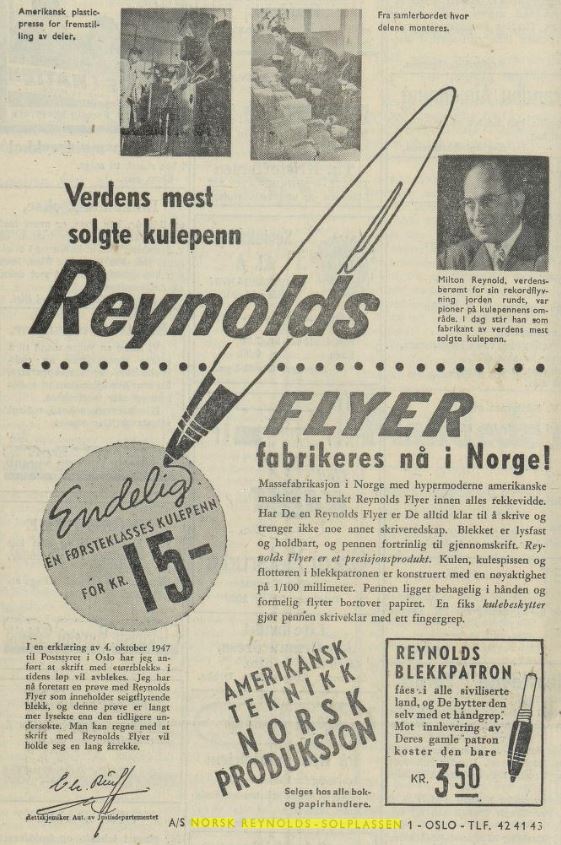
Rolf Ragnar Lie
The manager of Norsk Reynolds AS was called Rolf Ragnar Lie, and was a relatively controversial person in Norway in the post-war years. He was investigated during the post-war trials for having profited greatly from the war, but in the end somehow managed to evade punishment. After the war, he traveled a lot around Europe, and eventually married a German widow who was worth several millions. He then became the manager at Norsk Reynolds. Another interesting fact here is that one of the people who had worked on the post-war trials, and had actually been an investigator on Lie’s case, ended up as a colleague of Lie in the management of the new pen factory. This came to light in the media in October 1948, when Lie was arrested on suspicion of having evaded registration of enemy assets. He was released the same day, but with a daily reporting obligation, and his own and his wife’s assets were seized. At this time, Lie had sold 100,000 ballpoint pens at a price of NOK25,- per piece, and 200,000 Flyer pens at NOK15,-, and the media speculated as to how he had paid the necessary fees for these pens to the parent company, which naturally had to have its share of the income. Doubts were cast as to whether Norwegian banks had agreed to transfer such large sums out of the country in the challenging tax landscape after the war, and many speculated whether Lie had outstanding funds from businesses in America, or whether the fees to Reynolds International had even been paid. “Will Norway need to spend millions on the ballpoint pens?” asked the newspaper Arbeidets Rett on October 18, 1948, and this was the start of a long series of scandals for Norsk Reynolds, which was to dissolve less than a year after they had started operations in Norway.
A month later, the Pricing Directorate launched an action against the company, under the suspicion that they had given incorrect information about the costs of pen production, and sold the pens for a much higher price than they were allowed to. On December 3, Norsk Reynolds was liquidated after a general assembly, but the managers were still responsible for the company’s fraud charges. In January 1949, newspaper VG wrote that “In the future, no higher price for these ballpoint pens will be approved than NOK3,- per piece, and it is then likely that the fabrication will fall away as far as Norway is concerned”. A court case was also announced, suggesting that the company had made an additional profit of over NOK 1.5 million on the pens that had been sold. Many newspapers also pointed out that the same pens that had cost NOK25 in Norway only cost NOK2 in the USA. This is where it becomes clear how Milton Reynolds ran his business, because Rolf Lie claimed that a fee was paid per pen for the Americans at NOK 8.75. The fee Norsk Reynolds paid to the parent company for producing the pens in Norway was more than four times as high as the selling price of the pens in the USA!
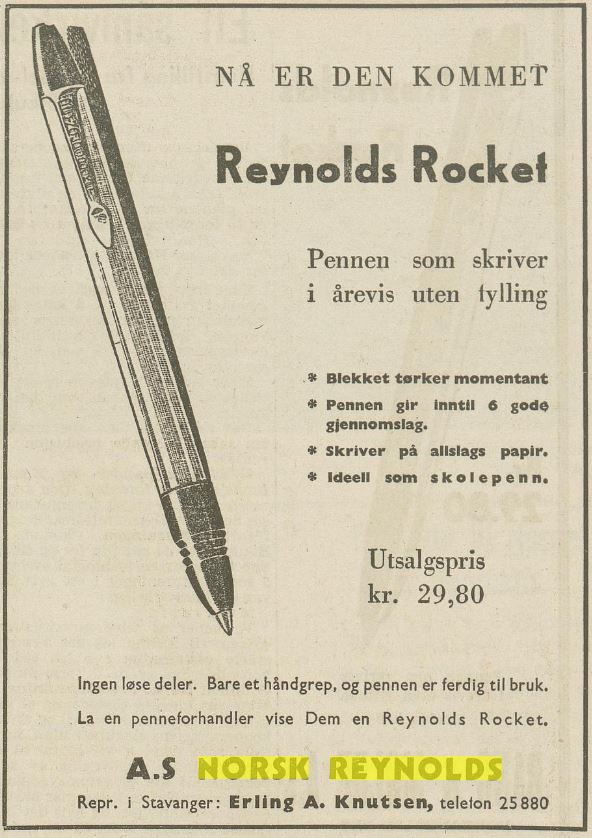
Reactions in the media
The comments in the newspapers were not long in coming, but surprisingly, much of the critism was not solely directed towards Norsk Reynolds, but also against the Pricing Directorate. At the end of January, this was printed in Østlandets Blad:
“The ballpoint pen that was sold for double the price. BECAUSE THE EXPERTS IN THE PRICING DIRECTORATE LET THEMSELVES BE DECEIVED.
In the case against “Reynolds Company AS” and “AS Norsk Reynolds” it is clearly demonstrated how hopelessly ineffective the Price Control is. There is an official admission that the Pricing Directorate has been tricked into setting a price that is 5 – five – times higher than what the price should have been.
The independent magazine “Farmand”, which puts the spotlight on this case, believes that it is much more scandalous, as most Norwegians who have been in the USA after the war have been able to tell that prices have fallen non-stop. The ballpoint adventure has been featured in a number of well-known magazines, including “Time”, so there is no excuse for the Pricing Directorate’s people not to know of the price drop. As early as March 1947, “Farmand” could determine that prices had fallen from the original 18 dollars down to 69 cents. If someone wants to claim that it is cheating to charge 18 dollars for an item that a few months later costs 69 cents, we strongly disagree, writes the magazine. Apart from the fact that 3 of the 18 dollars represents luxury tax, this applies to a new product, and it is really a great compliment to free competition that it can drive down the price of a product so quickly and strongly.”
Many expressed the view that there should be free competition in Norway rather than a Pricing Directorate, because competition between several companies would push the price down. But in Telemark Arbeiderblad there was a reader who pointed out that “When the ballpoint pen fraud was revealed, it was said that ‘this is what happened when there was no free competition’. The fact that there is hardly any room for free competition for a world-patented product is not mentioned“.
The trial
The trial against Norsk Reynolds took place in April 1949, and the Oslo District Court found Reynolds guilty on all counts. The company was fined just over NOK 1.5 million for the illegally high prices. In addition, the leaders Rolf Ragnar Lie, Gunnar Solvang and Kjell Borchgrevink received both fines and prison terms. Reynolds International was unwilling to pay, and the case was probably appealed, because in December 1949 there was a new newspaper report where it was said that all parties had been acquitted, except for Rolf Ragnar Lie, who received a fine of NOK 1,000 plus NOK 500 in legal costs. It’s unknown what information had come to light in the meantime, that led to this acquittal.
In other words, Reynolds’ history in Norway was short-lived. It started up towards the end of 1947, experienced great success in the late summer of 1948, and collapsed through a series of scandals related to both the war criminal who led the company, and not least this overcharge case. As soon as the trials were over, the Norwegian Reynolds adventure also ended. But what happened next to the parent company?
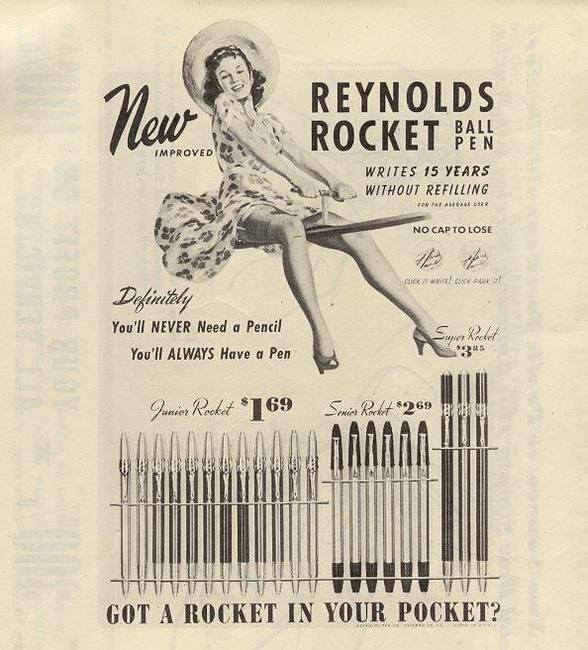
The adventure is over
Milton Reynolds quickly realized that the ballpoint adventure was over, and as soon as the initial hysteria subsided, there was no longer as much money to be had. When the initial glitter and glamor faded, Reynolds himself wasn’t that interested in continuing with it anymore. He had made a fortune in the brief flare of 1945-49, but felt that he didn’t have much more to gain, and he wasn’t able to compete against the big pen manufacturers who were now flooding the market with cheaper ballpoint pens. He split up the company, and sold it in 1949. Reynolds European was sold to a group in France, which continued to manufacture pens. Pen production was later moved to India, and Indian Reynolds still makes pens to this day. The French Reynolds company also still exists, but today works in sheet metal production.
The US branch was sold to the US government, who renamed it “The Reynolds Construction Company”, and used it as a shell company to transfer funds to foreign nations that they didn’t want to be open about in public. Many of the parts for the Reynolds Rocket pens were made by a Chicago company called Fisher-Armour Mfg. This company was owned by Paul C. Fisher , who later decided to try to improve the Rocket pen, and several years later ended up developing the Fisher Space Pen.
And Norway? Well, Norway had a fountain pen crisis towards the end of the 40s, partly because the government decided not to grant licenses for the import of fountain pens in 1949, because so many ballpoint pens were made in this country. The only problem was that most of these pens were manufactured by Reynolds, which no longer existed. The crisis led to extensive smuggling into the country of cheap and bad fountain pens, and eventually led to the establishment of several fountain pen factories in Norway in the early fifties.
Milton Reynolds himself retired, retreating to a vast estate he had purchased in Mexico. He made some investments later too, including in Iranian oil, and Syntex, the first company to start producing birth control pills. He also continued to travel extensively around the world, and died in 1976. Reynolds managed to do a lot during his life and career. Everything from buying and selling used car tyres, prefabricated houses, cigarette lighters and equipment for making signs (Reynolds Printasign was bought by his son in 1950, and kept it going for a couple of generations). He was an aviator and an adventurer, but it was probably as the Ballpoint King he reached his height, if only for a few post-war years. He was a ruthless rebel, who uprooted the pen industry, wreaked havoc with it, and set his own agenda. For better or worse. And he disappeared from the industry again as quickly as he appeared.
Sources
- Wikipedia
- reynolds-pens.com
- reynolds-european.fr
- Los Angeles Times, 12.08.1986: Printasign to Emphasize Computers : Company’s Equipment Creates Corps of ‘Silent Salesmen’ at Point of Purchase
- Believermag.com – Vintage Tech: The Ballpoint Pen
- Arbeiderbladet – 13.10.1948
- Arbeidets Rett – 18.10.1948
- Dalane Tidende – 26.01.1949
- Drammens Tidende – 23.02.1948
- Friheten – 14.10.1948
- Friheten – 06.08.1955
- Haldens Arbeiderblad – 27.09.1948
- Moss Avis – 17.04.1947
- Moss Avis – 01.09.1948
- Nidaros – 23.08.1948
- Nordlys – 04.12.1948
- Nordlys – 21.12.1948
- Oppland Arbeiderblad – 26.08.1948
- Porsgrunns Dagblad – 05.12.1949
- Rana Blad – 20.04.1949
- Ringerikes Blad – 24.02.1948
- Sarpsborg Arbeiderblad – 05.04.1949
- Telemark Arbeiderblad – 19.01.1949
- Telen – 01.12.1948
- Tromsø – 12.01.1949
- Vestmar – 06.09.1948
- Østlandets Blad – 28.01.1949
- Østlands-posten – 17.01.1949
Top image: Mr Milton Reynolds, arrived by Tasman flying boat. June 07, 1946. (Photo by Frederick John Halmarick/Fairfax Media via Getty Images).
One thought on “Nibby Sunday – Milton Reynolds – The Ballpoint King”